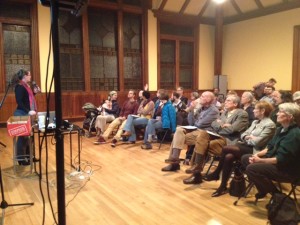By Lucy Arthur-Paratley
Mai’kwe Ludwig began her October 15 talk at the JP Forum by challenging the audience to think about their preconceived notions about “sustainable living.” “Most people think it’s a terrible way to live,” she said.
But Mai’kwe, who is the Executive Director of Dancing Rabbit Ecovillage, went on to show that life at Dancing Rabbit isn’t terrible at all – in fact, members lead great lives. They have access not only to basic amenities but also enjoy a strong sense of community, an aesthetic neighborhood, and delicious food.
How do they achieve that while also lowering their resource use towards 10% of the American average?
Dancing Rabbit has a few central tenets and then each resident is free to adapt their own life as they see fit. For example, they share large common spaces including a restaurant, dance studio, kitchen, and gathering spaces so their homes can be small. But the amount of time residents spend in the communal space is at their own discretion. Similarly, houses need to be constructed following specific guidelines of resource use and size (they average 230 sq/ft per person) but some chose to bring in a crane while others built their homes by hand. There are no personal vehicles parked at the Ecovillage; instead residents share cars and work together to get errands and appointments done efficiently, only one example of how their community stays knit together. The idea behind these individual adaptations to the community standards is that sustainability “needs to be locally driven” for it to succeed.

They also use other innovations and “vintage” ideas that they have brought back from our less resource-dependent past. Instead of pristine water in commodes, they use compost toilets. As Ludwig explained, “So many people don’t have potable water and we [Americans] crap in it.” They use insulated boxes to finish cooking some of their food to reduce their use of resources in cooking. They use both passive and active solar energy, with both south-facing windows and south-facing solar panels.
“It doesn’t suck,” Ludwig stated, in the understatement of the evening. And it isn’t only for the wealthy. Residents at Dancing Rabbit fall across the income spectrum with a group making only 1/4 of the average American income, according to Ludwig.
But she also argued that this dramatic reduction in resource use is necessary. The second portion of her talk was devoted to the realities of climate change. As she put it, “We have actually changed the climate.”
Instead of adopting what she terms the “pina colada mindset,” whereby we equate climate change to warmer weather and the possibility of a Florida vacation in Boston year-round, she argued that we need to really reckon with the realities of climate change.
Reading from Naomi Klein’s This Changes Everything and sharing data on geological climate data, Ludwig made it clear that the question is not “If?” or “when?” but “How much, how quickly?” Sustainability, she argued, takes compassion because our choices are not ethically neutral. Instead, each choice we make impacts others and disproportionately impacts people who have been historically oppressed. She incorporated a clear anti-racist message into this portion of her talk. People of color are disproportionately affected by climate change and, in response, are leading the movement on against climate change. Instead of using racism as an excuse, she called on white people to love people of color and step up to act on climate change.
Her specific recommendations for actions audience members could take focused on localization and a reduction in consumption. “Don’t fly,” she said. Trains are her prefered method of travel. Ultimately, Ludwig urged audience members to “choose again.” Instead of focusing on our past transgressions against the climate, she urged the audience to see themselves as adaptable — “we can adapt to different choices so choose again.”
